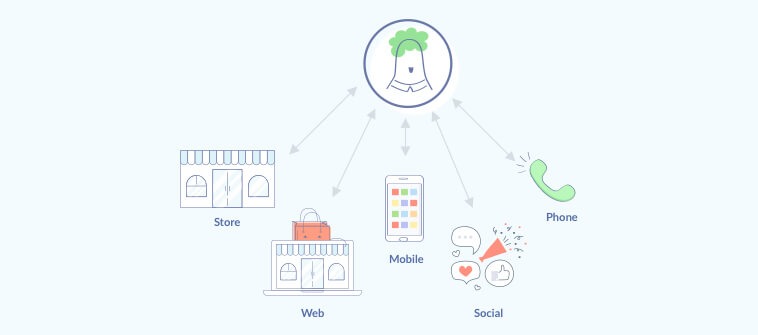For many years, marketing and customer service have been running in parallel lines, helping businesses acquire and retain customers.
While the former helps businesses promote and sell their services based on industry research and advertising, the latter offers assistance and advice to people already using a brand’s product or service.
But lately, both customer service and marketing are working in unison, helping brands capture attention, generate more business and guide customers simultaneously.
A great example of this is how Netflix is combining customer service and product promotions with its social accounts.
Netflix and chill? No, really. https://t.co/ezcZ7V0peN
— Netflix (@netflix) July 22, 2015
Their ‘Netflix & Chill’ internet slang has helped them gain a fair amount of attention amidst their target audience. However, they’re also using their marketing platforms to offer support to customers with witty interactions.
Understand that such good interactions encourage customers to spread the word about your efforts to create an awesome experience for them online. And this acts as a marketing mechanism for the brand.
But the question is, where should you start?
Don’t worry, we’re here to help you out. In this blog, we’ll help you explore the effects of customer service and marketing on each other, why they should be used together, and how to integrate customer service in a marketing plan.
How Does Customer Service Affect Marketing?
According to a research, 88% of consumers consider online customer service reviews when making a buying decision.
88%, phew that’s a lot of customers considering whether your services have great recommendations from people online or not. The same research also found that 39% of customers would avoid having any transactions with a business if they had one bad customer service experience with them.
This goes on to show that customer service is increasingly becoming one of the deciding factors for people to invest in a business. In short, customer service cannot be neglected anymore.
It has also become a benchmark that can impact your brand image and, if not done right, can easily hamper your marketing efforts at the same time.
That’s why customer service is important in marketing.
Why Marketing and Customer Service Should Work Together
1. Improve Cross-team Collaboration
Understand that besides your delighted customers, happier employees also act as business promoters in the market. In fact, employees who are engaged more are likely to improve customer relationships, with a resulting 20% increase in sales.
But the question is, where should you start from when it comes to both customer service and marketing teams?
Well, we’d suggest you to have an open conversation for better customer service and marketing alignment first. Not only will this improve engagement between both the teams but will also encourage both teams to collaborate further.
Doing so, can help you avoid seeing a picture where the customer support team is waiting for the marketing team to bring in leads or the marketing team losing out on qualified leads due to bad customer support services.
Cross-departmental collaboration and consistent engagement can help both the teams to:
- Develop a connection regarding every experience a customer has with the organization
- Overcome the blame game where teams say ‘my job finishes here’ and ‘yours starts there’
- Understand the bigger picture that gives them a sense of meaning towards their work
- Learn how to appreciate each other’s work
With such engagement results, it’ll become easier for your business to give your employees workplace satisfaction and motivate them to do better going forward.
2. Create Seamless Customer Service Experiences
Besides improving collaboration between the marketing and customer service teams, there is another pivotal reason for them to work together – create a seamless customer service experience. We’ll discuss how the two teams can work together to create better experiences for your customers.
a. Identify the Right Buyer Persona
It’s not just the marketing team that needs to know about the right buyer persona. Your customer service team should also know who you’re targeting and how your brand can help them out.
If anything, both teams can work on identifying the right buyer persona for the company. The marketing team can do thorough audience research using tools like Google Analytics and social media analytics to compile data on existing customers and social audience such as:
- Age
- Language
- Location
- Interests
- Challenges
- Stage of Life
The marketing team can also check out the competition by using platforms like Buzzsumo. It will help them understand the type of content their competitors are sharing across social channels, along with engagement data.
Whereas for the customer service team, they can help your business identify customer pain points better. Since a lot of people end up asking for assistance in case they don’t find what they’re looking for, the customer service team can help your business look into those pain points better.
You’ll be able to answer questions like:
- What challenges are your potential customers trying to resolve?
- Why did they approach your brand?
- Are there particular factors holding them from trying your brand?
Once the customer pain points, dilemma, needs, and interests are clearer, it will be easier for your business to decide:
- What voice they’d like to use to market their brand?
- How to set a brand messaging that resonates with the pain points of the customers
- What platform to use to market and communicate with the customers?
These efforts will help the marketing team to attract the right audience and provide the best product offers that match their buyer’s expectations. The content efforts would be more streamlined and they’ll be able to help product teams to work on better strategies to launch the next product.
b. Create More Focused Communication Strategies
A lot of customers resort to social media platforms in case they have complaints with the brand. They’ll tag or sometimes even ask their followers to share their experience with others they know. It’s like their word spreads like wildfire, hard to control and leaves a lot of repercussions behind.
But the problem here is, how do you deal with such customer complaints on your social media platform?
You can’t assign complaints to your customer support team and engagement posts to your marketing team. That’s because you lose on time and effort to first identify what kind of post has the customer tagged you in and then come up with a solution for it. This strategy won’t guarantee a seamless customer experience either.
That’s why you need a focused person/team to manage communication with your customers. That person or team should know how to deal with complaints and engagement posts at the same time. With that approach, it’ll be easier for your business to save more time and effort efficiently.
3. Earn More Revenue
Another benefit of your marketing and customer service teams working together is to see your revenue soar.
The customer service team can connect and help your prospects to understand why your brand is the solution to their challenges. Whereas, your marketing team can help prospects get acquainted with your brand better and let them know what’s new that they can check out by implementing effective strategies across different platforms.
As a result of their efforts, you can gain new customers and even retain the existing ones who can end up returning to your brand for future purchases. With their efforts, you’ll gain more loyal customers who’ll later be your brand promoters and attract more new customers for your business.
5 Ways Customer Service and Marketing can Work Together
Now that you understand why customer service and marketing strategies should work together, it is time you learn the different results they can produce. You’ll see how marketing and customer service relationship can help you reap better results for your brand.
Let’s dive in.
1. Identify Better Content Creation Ideas
You’ll notice changes in your content creation ideas once the marketing and customer service teams collaborate.
Both the teams can identify knowledge gaps by keeping a track of:
- What keywords were used by visitors to find relevant self-help articles in the knowledge repository?
- What articles have the competitor websites covered and how much engagement have they gathered with those articles?
That’s not all. Both the teams can use chat transcripts to identify common challenges. This can help them create canned messages that reduce the response time and enable operators to resolve a problem faster. And in case your live chat also integrates with a knowledge base just like ProProfs Chat does, then it’s easy to create new help center articles that will be visible in the chat widget.
Understand that you’re not just using customer service as a marketing strategy here. This will help the customer service team to reduce complaints and at the same time help marketing teams understand if the content they’re working on is targeting the right audience or not.
2. Identify Opportunities to Upsell & Cross-sell
Both marketing and customer service teams can help you cross-sell and upsell that ultimately helps you boost your revenues. We know that the customer service team does this proactively while they are in conversation with one of the customers.
But the question is, how is marketing team helping your business upsell and cross-sell products?
Unlike the customer service team, the marketing team isn’t convincing prospects in real-time to increase their order value or add another product to their carts. If anything, they come up with interesting social media marketing and customer service strategies to encourage people and add product combinations or even upgrade to a premium version of a certain plan.
Take Amazon for example.
Amazon is using its benefits to create upsell opportunities and show customers what’s beneficial for them. This kind of customer involvement can help make a sale.
We need to understand that the role of the marketing team here is to help their customer service team get acquainted with prospects who are likely to show interest in such opportunities.
If marketing teams create actionable content that talks about the benefits of integrating a specific tool with another, then they are creating opportunities for upsell and cross-sell. These opportunities can turn out to be prospects once they contact the customer service team for more information. This teamwork can help your business boost sales efficiently.
3. Work on a Unified Brand Messaging
Brand messaging helps customers understand if they can relate to the ideology of a business or not. If customers fail to understand the messaging, then it is possible to see them moving on to the next competitor in line. In that case, it becomes all the more crucial for marketers to work on a unified brand messaging that customers can relate to. But to build that messaging, your marketing team needs to understand:
- The common concerns and challenges of the customer
- What really encourages customer to return to a brand
- Have the marketing efforts helped the organization capture the right target audience’s attention
Fortunately, the customer service team can offer data such as browsing history, chat transcripts, ratings and more to help marketers address these concerns and efficiently work towards a messaging that the target audience can relate to.
4. Create Better Customer Loyalty Programs
A brainstorming session between customer service and marketing teams can solve a lot of marketing challenges, one of them being how to promote a loyalty program among customers.
You definitely want to create a loyalty program that customers eagerly want to join. But at the same time, it is important to see that customers do not quit the loyalty program otherwise it won’t be called a success. That’s where your customer service promotion strategies can back your program and prevent disloyalty.
Note: Here your customer service and marketing strategy won’t collide. When we speak of customer service promotion strategies, we mean your operators can offer discounts during an ongoing conversation to entice your customers to join your loyalty programs.
And such attempts can later be measured by customer effort scores (CES). This will help you identify areas that create friction between the brand and the customers. Later, your customer service team can share its findings with the marketing team who can leverage this data to not just enhance the takeaways of the loyalty program but also its marketing strategy.
5. Set Realistic Customer Expectations
Is there another way in which customer service can affect marketing team efforts?
Your customer service team can also help the marketing team set the customer expectations from the get set go. Well, you may ask how is that possible.
Understand that the customer service operators come across a lot of instances where customers have misleading or inadequate expectations from the brand. And if these expectations are not met, customers are likely to leave with disappointment.
That’s not something your business can afford. This is where the customer service team can share these misleading expectations with the marketers who can leverage this data to modify their strategies.
Merge Customer Service & Marketing Teams for Better Outputs
Customer service was becoming a prominent marketing strategy for our businesses even before we realized it. That’s because customer’s expectations shifted from factors like pricing of the product to the experience of the product.
When both teams work in unison, they can modify existing marketing strategies that help them set realistic customer expectations, create a unified brand messaging, identify new upsell opportunities and more. Besides that, both customer service and marketing teams can identify and create effective content strategies that fill the knowledge gap for both the teams.
Now that we’ve seen how customer service and marketing can work together, let’s take a look at some of the frequently asked questions.
What can marketers do to improve customer service?
Marketers can help to create a positive image for the customer service teams by promoting instances of customer success. They can either be through testimonials circulated via social media platforms or showcasing instances of great customer service experience through their marketing content.
How retail customer service skills apply to marketing?
There are some best practices of retail customer service that can be applied to marketing as well. For example, you shouldn’t restrict marketing to a single platform just like customer service. You need to have access to different platforms that help you capture customer attention and boost engagement. Also, you need to learn to attract customers with what they want and not what you think they want. That’s why you need to also emphasize on return policies, payment options, and others when marketing for your brand.
How to improve customer service with social media marketing?
There are a lot of brands that are already working towards improving customer service via their social media marketing platforms. Your business can respond to customer complaints and offer solutions when customers tag your brand in their statuses. You can even let your customer know that the solution is on its way and they won’t be facing the same problem again. This practice instills trust and loyalty for not only that customer who complained but also for those who follow your brand on social media platforms.
FREE. All Features. FOREVER!
Try our Forever FREE account with all premium features!







